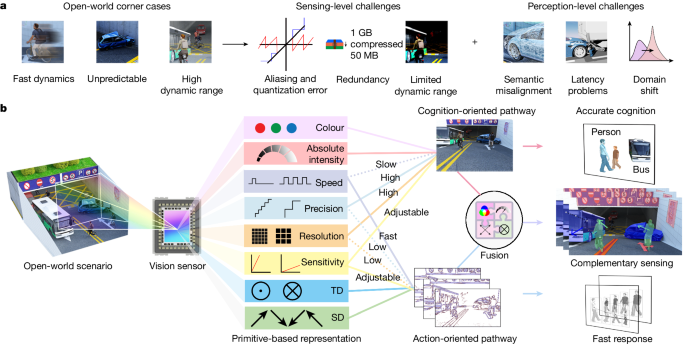insight - Computer Vision - # Complementary Vision Pathways for High-Performance Open-World Image Sensing
A Vision Chip with Complementary Pathways for Robust Open-World Sensing
Core Concepts
A novel vision chip, Tianmouc, employs a complementary sensing paradigm inspired by the human visual system to enable accurate, fast, and adaptive perception in diverse and unpredictable open-world scenarios.
Abstract
The content presents a novel vision chip called Tianmouc that addresses the challenges faced by traditional image sensors in dealing with dynamic, diverse, and unpredictable scenes in open-world applications. The key insights are:
The vision chip is inspired by the human visual system, which parses visual information into primitive-based representations and assembles these primitives into two complementary pathways: a cognition-oriented pathway for accurate cognition and an action-oriented pathway for rapid response.
Tianmouc incorporates a hybrid pixel array and a parallel-and-heterogeneous readout architecture to realize this complementary sensing paradigm. This allows it to achieve high-speed sensing of up to 10,000 fps, a dynamic range of 130 dB, and advanced spatial resolution, speed, and dynamic range performance.
Tianmouc also adaptively reduces bandwidth by 90%, making it suitable for diverse open-world applications. The authors demonstrate the integration of Tianmouc into an autonomous driving system, showcasing its abilities to enable accurate, fast, and robust perception, even in challenging corner cases on open roads.
The primitive-based complementary sensing paradigm helps overcome fundamental limitations in developing vision systems for diverse open-world applications, where traditional image sensors face substantial challenges.
A vision chip with complementary pathways for open-world sensing - Nature
Stats
Tianmouc vision chip achieves a sensing speed of up to 10,000 fps.
Tianmouc vision chip has a dynamic range of 130 dB.
Tianmouc vision chip adaptively reduces bandwidth by 90%.
Quotes
"The primitive-based complementary sensing paradigm helps in overcoming fundamental limitations in developing vision systems for diverse open-world applications."
"Leveraging the characteristics of the complementary vision pathway, Tianmouc achieves high-speed sensing of up to 10,000 fps, a dynamic range of 130 dB and an advanced figure of merit in terms of spatial resolution, speed and dynamic range."
Key Insights Distilled From
by Zheyu Yang,T... at www.nature.com 05-29-2024
https://www.nature.com/articles/s41586-024-07358-4
Deeper Inquiries
How can the complementary vision pathways in Tianmouc be further optimized to improve the trade-off between accuracy and speed for different open-world applications?
The complementary vision pathways in Tianmouc can be optimized by fine-tuning the balance between the cognition-oriented pathway and the action-oriented pathway based on the specific requirements of different open-world applications. For applications where rapid response is critical, such as autonomous driving in dynamic environments, more emphasis can be placed on the action-oriented pathway to prioritize speed over accuracy. On the other hand, for tasks that demand high precision and detailed cognition, such as medical imaging or surveillance, the cognition-oriented pathway can be enhanced to ensure accurate processing of visual information. By dynamically adjusting the contribution of each pathway based on the application's needs, the trade-off between accuracy and speed can be optimized to deliver optimal performance across a wide range of open-world sensing scenarios.
What are the potential limitations or drawbacks of the primitive-based representation approach used in Tianmouc, and how can they be addressed?
While the primitive-based representation approach used in Tianmouc offers advantages in terms of efficiency and adaptability, there are potential limitations that need to be addressed. One drawback is the risk of oversimplification, where complex visual information may be inadequately represented by primitive features, leading to loss of detail and accuracy in the final output. To mitigate this limitation, advanced algorithms for feature extraction and pattern recognition can be integrated into the system to enhance the richness and diversity of primitive representations. Additionally, incorporating hierarchical processing layers that combine primitives at different levels of abstraction can help capture more nuanced visual cues and improve the overall fidelity of the representation. By addressing these limitations, the primitive-based approach can be refined to achieve a more comprehensive and nuanced understanding of the visual world.
What other biologically-inspired design principles could be explored to develop more robust and adaptive vision systems for open-world sensing?
In addition to the complementary vision pathways inspired by the human visual system, other biologically-inspired design principles can be explored to enhance the robustness and adaptability of vision systems for open-world sensing. One promising approach is the integration of attention mechanisms that mimic selective visual attention in humans, allowing the system to focus on relevant regions of interest while filtering out distractions. By incorporating attentional mechanisms, vision systems can improve efficiency and accuracy in processing complex scenes with varying levels of saliency. Furthermore, exploring recurrent neural networks that emulate the feedback loops in the brain can enable vision systems to learn from past experiences and adapt to changing environments over time. By leveraging these biologically-inspired design principles in conjunction with the complementary vision pathways, vision systems can achieve greater resilience and flexibility in addressing the challenges of open-world sensing.
0
